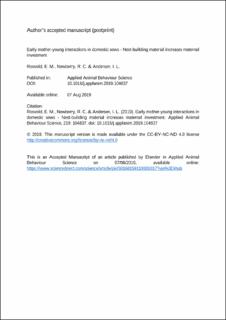Early mother-young interactions in domestic sows - Nest-building material increases maternal investment
Peer reviewed, Journal article
Accepted version
Permanent lenke
https://hdl.handle.net/11250/2653661Utgivelsesdato
2019Metadata
Vis full innførselSamlinger
Originalversjon
Rosvold, E. M., Newberry, R. C. & Andersen, I. L. (2019). Early mother-young interactions in domestic sows - Nest-building material increases maternal investment. Applied Animal Behaviour Science, 219: 104837. doi: 10.1016/j.applanim.2019.104837Sammendrag
Nest building is important in sow preparation for motherhood. However, straw or other bulky materials can block drains, and a finer-grained material such as peat is of interest as an alternative. The main aim of this study was to evaluate effects of different nesting materials on maternal behaviour during farrowing and early lactation. Norsvin Landrace x Swedish Yorkshire sows (n = 54) were loose-housed in individual farrowing pens with wood-shavings as litter. Mean (± SE) parity was 2.9 ± 2.0 (range 1–9), and 16 were primiparous. They were provided with peat (n = 18) or straw (n = 17) as nesting material from two days before expected farrowing until they farrowed, or received wood shavings litter only (controls, n = 18). From video recordings positive (i.e. sniffing, grunting, nudging) and negative (i.e. pushing, threatening barks, biting) communicatory behaviours from sow to piglets during farrowing (≤4 h) and on Day 1 post-partum (4 h) were registered by one-zero sampling at 1-min intervals. Nursing behaviour on Day 2 post-partum (6 h) was registered by continuous observation. During farrowing, sows provided with straw or peat as nesting material showed a lower frequency of negative communication towards piglets compared to controls (P < 0.05). Sows provided with straw had a higher proportion of sow-initiated nursing bouts and successful nursing bouts (i.e. with milk let-down) terminated by the piglets than sows in the peat and control groups. There were also differences in maternal behaviour across parities 1, 2–3 and ≥4 (P < 0.05). Sows of parity ≥4 exhibited a lower frequency of negative communication during farrowing than younger sows. On Day 1 post-partum, sows of parity 2–3 performed a higher frequency of positive communication than sows of other parities. The proportion of sow-initiated nursing bouts was higher in sows of parity ≥4 than in primiparous sows, whereas the proportion of successful nursing bouts terminated by piglets was higher for primiparous than older sows. Positive sow-to-piglet communication increased with litter size during farrowing, but declined with litter size on Day 1. Proportion of sow-initiated nursing bouts increased with litter size, whereas the proportion of successful nursing bouts terminated by piglets decreased. The number of piglets without a teat during milk let-down increased with litter size (P < 0.05). These findings show that both peat and straw were associated with a lower rate of negative sow-to-piglet communication during farrowing compared to sows given wood shavings alone. Provision of straw, particularly, resulted in nursing behaviour indicative of increased maternal investment. Early mother-young interactions in domestic sows - Nest-building material increases maternal investment
Beskrivelse
Author's accepted version (postprint). This is an Accepted Manuscript of an article published by Elsevier in Applied Animal Behaviour Science on 07/08/2019. Available online: https://www.sciencedirect.com/science/article/pii/S0168159119301017?via%3Dihub

